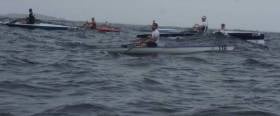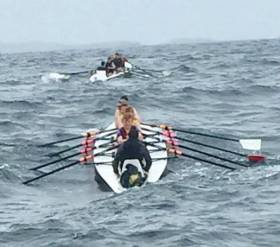Displaying items by tag: Irish Offshore Championships
Arklow Big Winners at Irish Coastal Rowing Championships
#Rowing: Myross won the men’s quadruple, while Sionna Healy of Arklow took the women’s single on the second day of the Irish Offshore Rowing Championships in Kerry. It was a good event overall for Arklow. They won the men’s and women's doubles on Saturday, while on Sunday – which featured races deferred because of disruptive winds – they won the mixed doubles, through Alan Goodison and Andrea Kinsella.
Irish Offshore Championships, Kerry
Saturday
Men
Double: Arklow (J Whooley, A Goodison) 20.17.
Single: Loughros Point, Donegal (P Boomer).
Women
Quadruple: Killorglin (E O’Donovan, A Tyther, K Boyle, R O’Donoghue; D Leahy) 22:48.
Double: Arklow (R Ireson, MA Kent).
Sunday
Men
Quadruple: Myross (V Browne, K McCarthy, J Lupton, A O’Sullivan; C Deasy) 17:12.
Women
Single: Arklow (S Healy) 24:32.
Mixed
Double: Arklow (A Goodison, A Kinsella) 18:53.
Boomer Best at Offshore Rowing Championships
#Rowing: Patrick Boomer won the single sculls at the Irish Offshore Championships at O’Carroll’s Cove near Caherdaniel in Kerry. Boomer represented Loughros Point in Donegal and hopes to go on to row for them at the World Coastal Rowing Championships in Canada in October.
John Whooley of Skibbereen won a title – for Arklow. The Corkman teamed up with Alan Goodison to take the men’s double.
Kerry club Killorglin won the women’s quadruple and Arklow the women’s double.
The final of the men’s quadruple, the women’s single and the mixed double will take place on Sunday as the wind made conditions unsuitable on Saturday.
Irish Offshore Championships, Kerry
Men
Double: Arklow (J Whooley, A Goodison) 20.17.
Single: Loughros Point, Donegal (P Boomer).
Women
Quadruple: Killorglin (E O’Donovan, A Tyther, K Boyle, R O’Donoghue; D Leahy) 22:48.
Double: Arklow (R Ireson, MA Kent).
Irish Offshore Rowing Championships Set for Kerry
#Rowing: Portmagee Rowing club will host the Irish Offshore Rowing Championships on Saturday, September 8th. The event will be run by Rowing Ireland and the venue is O’Carroll’s Cove beach bar near Caherdaniel in County Kerry. This will be the first time this event will be held in Kerry.
More than 80 crews, made up of 220-plus oarsmen and women will compete for national titles. The event is the Fisa ranking event for the World Coastal Rowing Championships 2018 which will be held in Canada in October.
Kerry rowers have a good record in Coastal/Offshore Rowing. Ireland international Monika Dukarska, from the Killorglin Rowing Club, is a double world champion in the women’s single. Johnny Casey, whose grandfather was one of the legendary Caseys of Sneem, was the Irish men’s single champion last year.
This year’s course for the Offshore Championships is the same stretch of water that the Caseys, the "toughest family on earth", would have trained and raced on in the Seine boat during their heyday in the 1920s and 1930s. Johnny also teamed up with his brother James and uncle and father, Steve and Patrick, to win the All Ireland senior men’s four 20 years ago.
This year, the Courtmacsherry men’s quad crew who have defeated all comers over the last few years, put their title on the line. Waiting to take them on are the might of Muckross. Paul Griffin, an Ireland Olympian in Athens in 2004, when his Ireland lightweight four reached the A Final, and Beijing in 2008, is set to be in their ranks.

























































